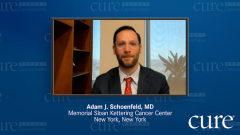
The Potential Role of TIL Therapy in NSCLC
Adam J. Schoenfeld, MD, considers the benefits and limitations of tumor-infiltrating lymphocyte (TIL) therapy and discusses its potential impact on the treatment landscape in non–small cell lung cancer.
Adam J. Schoenfeld, MD: It’s too early to define the potential role of TIL [tumor-infiltrating lymphocyte] therapy in non–small cell lung cancer because we’re in very early phase clinical trials right now, but the early data have been quite promising. There has been a report out of the Moffitt Cancer Center by Ben Creelan, [MD,] that showed a response in approximately 1 out of every 3 patients who received the therapy, including 2 patients who had tumors throughout their body entirely disappear on treatment, or what we call a complete response. These responses were ongoing for over a year. If we continue to see results like that, this could be a therapeutic option for patients who’ve progressed on other immunotherapies. It could also perhaps be used combined with immunotherapy or in other combinations.
TIL therapy can meet several unmet needs for patients in the future if it’s found to be both effective and tolerable. Right now, many patients who have progressed on first-line therapy with chemotherapy and immunotherapy have limited treatment options remaining. They’re destined to receive single-agent chemotherapy with low response rates that don’t typically yield long-term benefit. TIL therapy could fill a significant unmet need in that population of patients if it’s effective and tolerable.
One of the benefits of TIL therapy is that it can identify cancer cells anywhere in the body, such as inside the lung, liver, bone, or brain. Because you’re using your own immune cells, these cells know how to travel throughout the body and identify tumor cells anywhere.
There are many potential benefits to TIL therapy. We’re in the early phase trials right now, but I hope that this could be a breakthrough for patients who have resistance to immunotherapy or for whom immunotherapy is not expected to work. The limitations will be the requirement of tumor resection and possibly the toxicity from other drugs given with TIL therapy, such as chemotherapy and IL-2. But newer technologies are becoming available that may make these processes easier. For example, there are newer trials exploring whether TIL products can be generated from biopsies rather than resection specimens, which would be much more feasible for patients to undergo. Similarly, there are IL-2 agents that are much less toxic being explored as well. I’m very excited about the potential opportunities to use TIL therapy in various settings.
Transcript edited for clarity.







